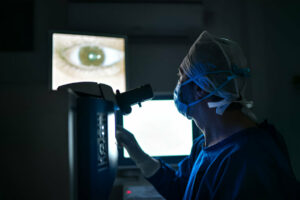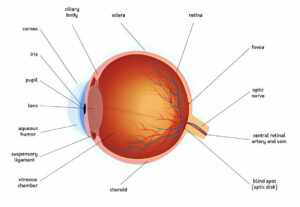Trachoma, one of the world’s leading infectious causes of blindness, is caused by Chlamydia trachomatis bacteria. It primarily impacts children living in poverty but can affect anyone at any age.
Trachoma symptoms typically begin as inflammation of the tissue lining the eyelids (conjunctivitis or “pink eye”). A healthcare provider can diagnose it by looking for signs such as scarring inside of an upper eyelid and redness of its white portion.
Symptoms
Trachoma is an infection of the eye caused by repeated exposure to certain nonsexual strains (chlamydia) of Chlamydia trachomatis bacteria, leading to reddening, watering and irritation in both conjunctiva and cornea that eventually scars over time, rendering vision impossible. Trachoma is one of the leading infectious preventable blindness causes affecting people of all ages worldwide – it most often strikes rural areas or poor people living in unclean living conditions – while young children especially susceptible, however infection typically progress slowly with serious consequences only occurring later during adulthood.
Infections may spread through direct contact with an infected individual’s eyes, eyelids, nose secretions and throat secretions; or by touching objects contaminated with them such as towels and washbasins. Flies who have come in contact with eye or nasal discharge could also transmit it directly into human bodies.
At later stages of this disease, blood vessels grow across the cornea to form a film that blocks out light penetration and may result in blindness. Eyelashes may turn inward and rub against it further damaging it while weaker corneal walls form ulcers and thicken further hindering light penetration causing blurred vision.
Visual impairment and blindness can make life harder for individuals, particularly women who are two to four times more likely than men to become blind due to trachoma. Families must often rely on older daughters or other relatives as support sources, leading to poverty and social problems for everyone involved.
Health care providers can typically diagnose trachoma by looking at the eyelids. Swabbing may be used to test for infective organisms in order to send samples off to laboratories; this step may not always be necessary, however. Treatment options can range from antibiotics and surgery for correcting eyelid positioning; traveller should take extra measures in places with higher prevalence rates such as washing hands frequently and not sharing towels to protect their eyes.
Diagnosis
Trachoma is an eye disease caused by certain strains of Chlamydia trachomatis bacteria, which also causes genital infections. Trachoma spreads from person to person via contact with eye or nasal discharge from infected individuals – particularly young children – who act as sources of infection for others. Other means include sharing infected items like towels and handkerchiefs between individuals as well as direct personal contact between people; even insects such as flies can serve as vectors for transmission of infection between persons.
Trachoma symptoms include itchy eyes, mucus or pus in the eyelids or tears, photophobia (sensitivity to light) and blurred vision. It typically progresses slowly over several years due to repeated episodes of inflammation causing scarring inside of eyelids that causes them to turn inward and rub against cornea, further scarring it further and eventually leading to irreversible opacities or blindness.
Trachoma is most prevalent among poor and remote communities around the world, impacting about eight million people globally with active symptoms in countries considered endemic for this condition. It disproportionately impacts communities where water shortages, poor sanitation and living conditions create close personal contact that leads to poor hygienic practices; its onset typically begins in childhood – often among girls.
Trachoma can be diagnosed through a simple eye exam. Examiners look for signs such as scarring of the inner surface of the upper eyelid (trachomatous conjunctival scarring), abnormal redness in the white portion of eyes and improper blood vessel growth into cornea. Lab tests such as polymerase chain reaction can identify the bacteria causing trachoma; however, such tests are typically too expensive to be used effectively in communities where trachoma most frequently appears. Antibiotics may prevent long-term complications, including permanent vision loss, when taken early during an infection. Surgery may also be required to correct eyelid deformities and stop further outbreaks of disease; additionally, public health measures like frequent washing with clean water and practicing good hygiene practices, including not sharing towels or other articles can help.
Treatment
Chlamydia trachomatis, the bacteria responsible for trachoma, spreads easily via eye-eye contact or nose-nose contact between humans. Additionally, it can spread when infected towels or handkerchiefs are shared or when living space is shared by those living with someone infected. Trachoma infections tend to be most prevalent in communities with poor sanitation where close family contact exists such as schools for children living together in homes where water shortages impede adequate sanitation measures and water shortages make proper sanitation measures more difficult.
Early symptoms of trachoma often go undetected; however, repeated infections can eventually lead to scarring in both conjunctiva and cornea, vision loss and blood vessel growth across cornea (called neovascularization ), which obstructs vision further. Furthermore, scarring may cause upper eyelid to turn inward against cornea (trachomatous trichiasis ). This results in painful ulcers which become infected leading to permanent blindness.
Mild itching of the eyes and eyelids is often present. Discharge from the eyes may vary from clear to cloudy in texture and coat lashes or accumulate at corners of eyes. Sometimes there may be an uncomfortable grittiness that worsens with blinking or rubbing; reddening and swelling occur within red eyed tissues, while photophobia, or light sensitivity, is also commonly experienced.
Doctors typically diagnose trachoma by conducting an eye exam. Early treatment with antibiotics is generally more successful. Swabs from the conjunctiva can be taken and sent for testing by polymerase chain reaction (PCR) tests which detect antigens or DNA that indicate Chlamydial infection in a sample; this serves to confirm their diagnosis and establishes proof of it being present in their system.
Trachoma can often be treated using antibiotics in either eye ointment form or oral drugs, with both treatments helping reduce inflammation and prevent new scar tissue formation. Surgery may also be needed in some cases to correct eyelid deformities or remove corneas if necessary; lost vision due to trachoma can often be restored through medical or surgical means.
Prevention
Trachoma, one of the leading causes of infectious blindness worldwide, is caused by repeated eye infections with Chlamydia trachomatis bacteria that result in scarring around the eyes, eventually leading to vision loss over time. Most common in poor and rural areas with children most at risk. Transmission usually takes place through family contact as the infection spreads via contact with eye discharge from infected people or via flies carrying the bacteria.
As with other diseases, eyelash disorders are preventable with a comprehensive approach to targeting their root causes. This could involve surgery for in-turned eyelashes (trichiasis), antibiotics to combat active infection, facial cleanliness and environmental improvements (e.g. access to clean water and sanitation).
Ideal efforts at eliminating trachoma should be led by government-run regional population health units in partnership with primary health care services, and must include devising the most efficient method for identifying patients suffering from trichiasis and providing prompt surgical referral and treatment.
Education about trachoma and its prevention is an integral component of any effective intervention strategy, whether conducted through community-based organisations or schools. School-based interventions tend to be particularly successful due to high attendance by young children as well as acting as ambassadors of behaviour change for change within communities.
Utilizing audiovisual tools, like the National Eye Institute’s Trachoma Education and Awareness Toolkit available from their website, is one way of spreading the message about Trachoma disease. Translating into local languages ensures maximum impactful communication while decreasing blindness rates among those at highest risk for this condition.
Many countries are already making strides toward eliminating trachoma. Morocco, for instance, is making great progress toward meeting their goal of eliminating it by 2020–well before its global target date of 2040–due to strong partnerships and buy-in from their government, particularly their Ministry of Education who have included making it part of their curriculum and encouraging students to act as ambassadors of change within their own communities.















